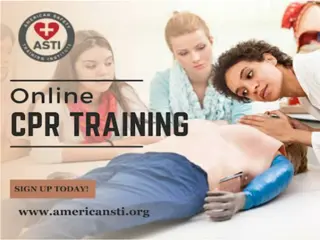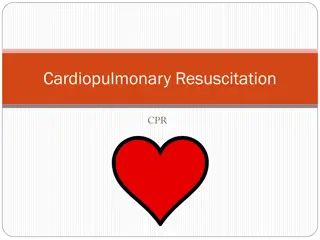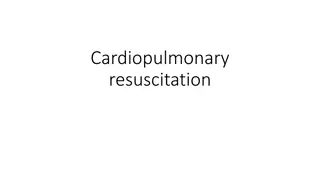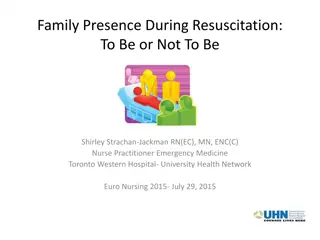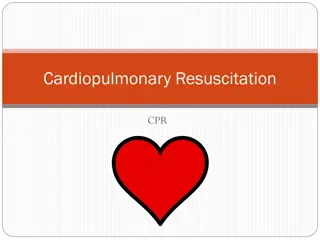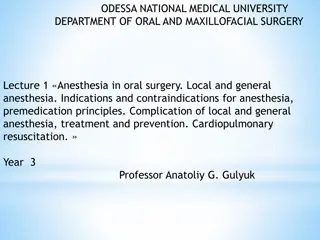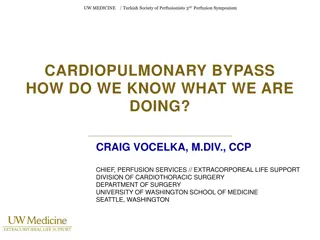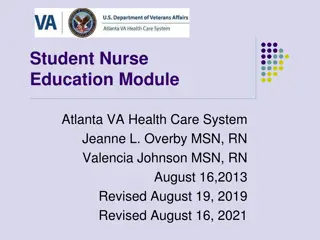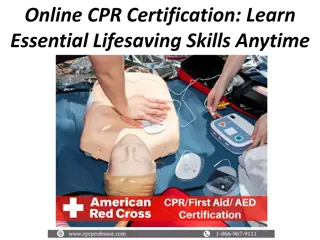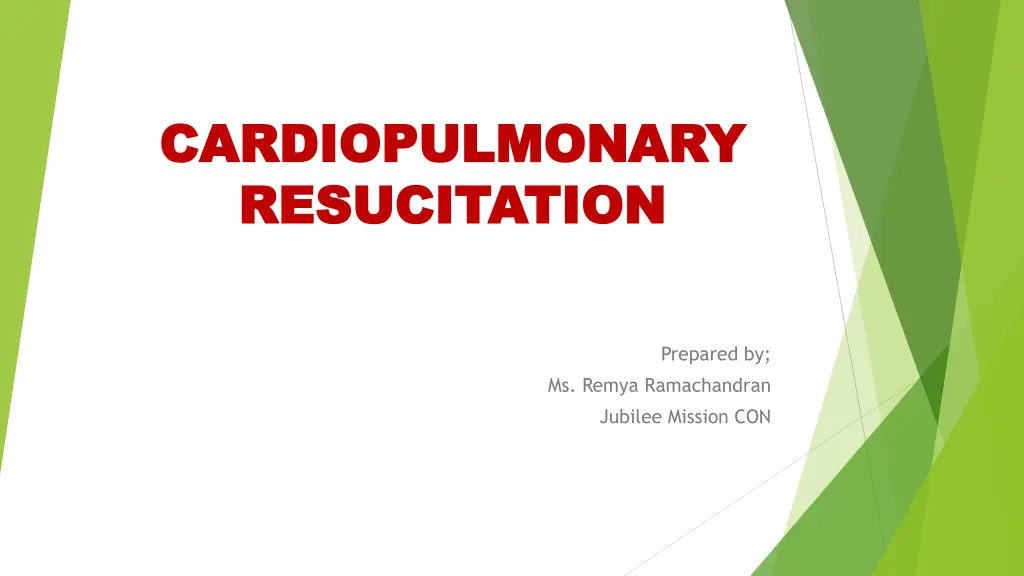
Understanding Cardiopulmonary Resuscitation: Importance and Procedures
Learn about the significance of cardiopulmonary resuscitation (CPR) in saving lives during cardiac emergencies. Explore the indications, procedures, and purposes of CPR to enhance your knowledge and potentially help in critical situations.
Download Presentation

Please find below an Image/Link to download the presentation.
The content on the website is provided AS IS for your information and personal use only. It may not be sold, licensed, or shared on other websites without obtaining consent from the author. If you encounter any issues during the download, it is possible that the publisher has removed the file from their server.
You are allowed to download the files provided on this website for personal or commercial use, subject to the condition that they are used lawfully. All files are the property of their respective owners.
The content on the website is provided AS IS for your information and personal use only. It may not be sold, licensed, or shared on other websites without obtaining consent from the author.
E N D
Presentation Transcript
CARDIOPULMONARY CARDIOPULMONARY RESUCITATION RESUCITATION Prepared by; Ms. Remya Ramachandran Jubilee Mission CON
Cardiovascular disease, disease of heart and blood vessels, is the leading cause of death in the world. Cancer is the second leading cause of death. The third leading cause is heart injury. Most people with a heart attack die before reaching a hospital. In order to save the lives of cardiac emergency victims, immediately available. first aid must be
Rescuers play a vital role and their knowledge and skills can mean the difference between life and death for many victims.
Definition : Is a Emergency procedure that combines chest compressions often with artificial ventilation in an effort to manually preserve the intact brain function until further measures are taken to restore spontaneous blood circulation and breathing in a person who is in cardiac arrest .
Indications 1. Cardiac. 2. Pulmonary. 3. Respiratory
Cardiac. Myocardial infarction, Heart failure, Dysrhythmia, Coronary artery spasm, Cardiac tamponed.
Pulmonary. Respiratory depression failure secondary to respiratory airway depression, impaired pulmonary embolus, retention of CO. ventilation such as pneumothorax,
Respiratory Drowning, suffocation head trauma neuro muscular paralysis drug over dose
SIGNS AND SYMPTOMS OF CARDIAC ARREST i. Apnea ii. Absence of carotid or femoral pulse. iii. Dilated pupil iv. Cyanosis v. Unconsciousness vi. Fits
Purposes of CPR 1. To initiate breathing 2. To restore blood circulation 3. Restore Cardio pulmonary functioning 4. Prevent irreversible brain damage from Anoxia.
COMPONENTS OF CPR
SITE FOR COMPRESSION SITE FOR COMPRESSION
CHEST COMPRESSION DEPTH During compressions to a depth of at least 2 inches (5 cm) for an average excessive chest compression depths (greater than 2.4 inches [6 cm]. is because a approximately 5 cm is associated with greater likelihood of favorable outcomes compared with shallower compressions. CPR, rescuers should perform chest adult, while avoiding This compression depth of
While there is less evidence about whether there is an upper threshold beyond which compressions may be too deep, a recent very small study suggests potential injuries (none life-threatening) chest compression depth (greater than 2.4 inches [6 cm]. from excessive
Chest Recoil: It is reasonable for rescuers to avoid leaning on the chest between compressions, to allow full chest wall recoil for adults in cardiac arrest. It is reasonable for rescuers to avoid leaning on the chest between compressions, to allow full chest wall recoil for adults in cardiac arrest. This is because of full chest wall recoil occurs when the sternum returns to its natural or neutral position during the decompression phase of CPR.
Chest wall recoil creates a relative negative intra thoracic pressure that promotes venous return and cardiopulmonary blood flow. Leaning on the chest wall between compressions precludes full chest wall recoil. Incomplete recoil raises intra thoracic pressure and reduces venous return, coronary perfusion pressure, and myocardial blood flow and can influence resuscitation outcomes.
ADVANCED CARDIAC LIFE SUPPORT Advanced cardiac life support or advanced cardiovascular life support (ACLS) refers to a set of clinical interventions for the urgent treatment of cardiac arrest, stroke and other life-threatening emergencies, as well as the knowledge and skills to deploy those interve.ntions medical
IMPORTANCE ACLS is built heavily upon the foundation of BLS
FIRST LINE DRUGS 1.INJ.ADRENALINE1ml Adrenaline is also known as Epinephrine which is a hormone, neurotransmitter andamedicine. Epinephrineisnormallyproducedbyboththeadrenalglandsand certainneurons.
It plays an important role in the fight-or- flight response by increasing blood flow to muscles, output of the heart, pupil dilation, and blood sugar. It does this by binding to alpha and beta receptors. It is found in many animals and some single cell organisms.
Mechanism of action: Is a direct-acting sympathomimetic drug that acts as an agonist at alpha and beta- adrenergic receptors. It produces vasoconstriction to counteract the vasodilation and resulting hypotension associated with anaphylaxis.
The bronchodilator effects of epinephrine and its ability to reduce mucosal bronchoconstriction and effort. edema relieve improve respiratory Epinephrine also down-regulates the release of histamine, tryptase, and mediators from mast improving respiratory function and reducing the pruritus, urticaria, gastrointestinal symptoms allergen exposure. other cells inflammatory and basophils, angioedema, which and after occur
CODARONE (Amiodarone) Class:AntiarrhythmicAgent Class III Indications: Management of life-threatening recurrentventricularfibrillation(VF)orhemodynamically- unstable ventricular tachycardia (VT) refractory to other antiarrhythmic agents or in patients intolerant of other agentsusedfortheseconditions.
CLASS III ANTIARRHYTHMIC AGENT, WHICH INHIBITS ADRENERGIC STIMULATION; AFFECTS SODIUM, POTASSIUM, AND CALCIUM CHANNELS; MARKEDLY PROLONGS ACTION POTENTIAL AND REPOLARIZATION; DECREASES AV CONDUCTION AND SINUS NODE FUNCTION.
NURSES ROLE IN CARDIO PULMONARY RESUCITATION
NURSING TEAM LEADER (USUALLY SENIOR WARD NURSE Identifies self as Nursing Team Leader, responsible for coordinating and directing emergent nursing care of the patient. Checks appropriate emergency call has been placed Starts timer as soon as the Emergency trolley arrives. Delegates available staff to roles appropriate to their level of practice: Airway, Compression, Monitor & Medications and Runner to collect or remove extra equipment, supplies, labs etc.
Establishes the patients weight and delegates someone to print out an Emergency Drug Worksheet (Icon on desktop of clinical computers). Ensures that the patient is placed on CPR back board. Reassigns nursing staff once the PICU nurse and additional staff arrive as required. Ensure someone is assigned to support family members. Documents initial and ongoing vital signs and cardiac rhythm, medication administration, procedures and patient s response to interventions on the CPR.
AIRWAY NURSE Summons help and initiates CPR as required until initial assistance arrives and then assumes responsibility for airway management. Maintains airway patency with use of airway adjuncts as required (suction, high flow oxygen, via Hudson mask, blob mask with O2 or bag valve mask ventilation). This role becomes the responsibility of the Emergency nurse on their arrival. Assist with intubation and securing of ETT
Inserts decompression post intubation as required. Assists with ongoing management of airway patency and adequate ventilation Supports less experienced staff by coaching/guidance e.g. drug preparation gastric tube and/or facilitates gastric
COMPRESSION NURSE If CPR in progress, assume responsibility for cardiac compressions (this includes ensuring that staff doing compressions are changed at regular intervals (eg every 2 minutes) to avoid fatigue resulting in inadequate compressions being delivered) Assess pulses (including pulse volume) and capillary refill as required Monitor and Medication Nurse Placement of monitors: ECG, O2 saturation and BP .
If a shock able rhythm is present (VF/VT) ensure AED or manual defibrillator pads are applied and connected. If CPR is in progress, prepare and independently double check and label 3 doses of adrenaline Prepare appropriate medications as per Team Leader request Prepare and administer IV fluids as per Team Leader request Announce medications to the Team leader as they are being administered. Document medications administered (including time)
DUTY MANAGER SUPPORTS LESS EXPERIENCED STAFF IN THE ABOVE ROLES AS REQUIRED. COMMUNICATES WITH ALL APPROPRIATE SERVICES WHEN REQUESTED. ENSURES OTHER PATIENTS ON THE WARD ARE ADEQUATELY CARED FOR AND IDENTIFIES AND AMENDS DEPARTMENTS STAFFING REQUIREMENTS. ENSURES BREAKS FOR STAFF FOLLOWING LARGE RESUSCITATIONS
CONCLUSION RESUSCITATION PROCEDURE OFTEN WITH EFFORT TO TO MANUALLY FUNCTION RESTORE BREATHING RECOMMENDED NO AGONAL CARDIOPULMONARY EMERGENCY COMPRESSIONS AN AN EFFORT FUNCTION UNTIL RESTORE SPONTANEOUS BREATHINGIN INA APERSON RECOMMENDED IN IN THOSE NOBREATHING AGONALRESPIRATIONS CARDIOPULMONARY EMERGENCY COMPRESSIONS OFTEN RESUSCITATION THAT WITH ARTIFICIAL MANUALLY PRESERVE UNTIL FURTHER SPONTANEOUS BLOOD PERSONWHO THOSE WHO BREATHINGOR ORABNORMAL RESPIRATIONS.. (CPR) (CPR) IS IS AN AN PROCEDURE THAT ARTIFICIAL VENTILATION PRESERVE INTACT FURTHER MEASURES BLOOD CIRCULATION WHOIS ISIN INCARDIAC WHO ARE ABNORMALBREATHING, COMBINES VENTILATION IN IN INTACT BRAIN MEASURES ARE CIRCULATION AND CARDIACARREST ARE UNRESPONSIVE BREATHING,FOR COMBINES CHEST CHEST BRAIN ARE TAKEN TAKEN TO TO AND ARREST..IT ITIS IS UNRESPONSIVE WITH FOREXAMPLE, WITH EXAMPLE,
Reference Brunner A. Suddarth's Medical-Surgical Nursing. Suma Psicol gica. 2004;13(1):15-31. Heitkemper MM, Dirksen SR, Lewis SM, Bucher L, Harding M. Medical-surgical nursing: assessment and management of clinical problems. Ignatavicius DD, Workman ML. Medical-Surgical Nursing-E-Book: Patient- Centered Collaborative Care. Elsevier Health Sciences; 2015 Jan 30.



